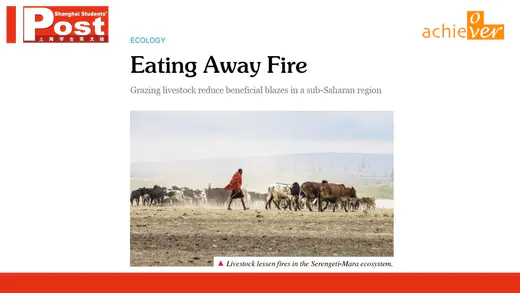《高中英语外刊阅读语篇精选》(第6辑)配套精品课

订阅专栏后播放音频

ssp


课程详情
【本课讲解文本和要点】
Eating Away Fire
Grazing livestock reduce beneficial blazes in a sub-Saharan region
• grazing
• blaze
• sub-Saharan
① The African continent has a wide variety of habitat types, but savanna ecosystems cover roughly half. And where there is savanna, there is fire. “It’s an important part of the ecology of the system,” says University of Liverpool ecologist James R. Probert. Burning allows grasses to dominate by keeping taller shrubs and thorn bushes from encroaching on the landscape. Loss of grasses could push out species such as wildebeest, which are famous for their spectacular annual migration.
• a wide variety of
• habitat type
• savanna
• keep sth. from doing
• encroach on
• landscape
• annual migration
② A decade ago researchers attributed decreasing fires within Tanzania’s Serengeti National Park to the recovery of wildebeest herds following an epidemic of rinderpest, a viral disease. When millions of wildebeest feed on grass, they remove fuel from the landscape, making fires less frequent and less severe.
• attribute A to B
• herd
• epidemic
• viral: virus
• feed on
③ But Probert and his colleagues found that even after wildebeest populations had stabilized by the mid-1990s, fires continued to decrease in the savanna-dominated Serengeti-Mara ecosystem covering the Tanzania-Kenya border (of which the protected Serengeti National Park is just one part). Their analysis of satellite data revealed that the region experienced a 40 percent reduction in wildfires between 2001 and 2014 — coinciding with dramatic increases in livestock in the area. They reported their findings in July in the journal Global Change Biology.
• stabilize
• savanna-dominated
• ecosystem
• National Park
• satellite data
• experience a reduction in
• coincide with
• journal
④ “If you have lots of herbivores eating the grass, then you have less fire. That’s well known,” Probert says. “But I don’t think anybody had realized the magnitude of the decline in fire and linked it to livestock before.”
• herbivore: herb-i-vore
• carnivore, omnivore
• carnivorous, herbivorous, omnivorous
• devour, savor
• magnitude = importance/large size
⑤ “This is a really interesting pattern,” says University of Guelph biologist John Fryxell, who was not involved in the study. He cautions, however, that 15 years’ worth of data is still a fairly small amount of information from which to draw definitive conclusions. “What a short-term correlation like that suggests is there’s something interesting here that could provide the grounds for a deeper experimental analysis,” he adds. That research could include artificially controlling fire frequency or grazing intensity in certain areas and then monitoring the landscape’s response over time.
• caution
• draw definitive conclusion
• short-term
• ground
• experimental analysis
• artificially control
• monitor
⑥ Probert notes that some of these places are suffering from a kind of “tragedy of the commons,” with livestock using up more resources than an area can sustain. He says conservationists might consider working with farm owners to develop a rotational grazing plan, thereby spreading the animals’ impact over time and space. Studies such as Probert’s continue to reveal the ways wild places like the Serengeti-Mara are closely linked to human activity.
• tragedy of the commons
• sustain: sustainability
• conservationist: conserve, conservation
• rotational grazing plan: crop rotation
• spreading the impact over time and space
• human activity